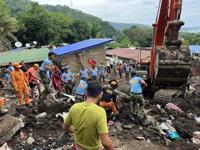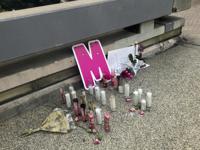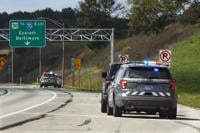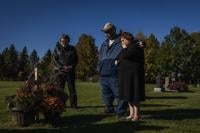TALISAY, Philippines (AP) — As a storm pounded his rural home, Raynaldo Dejucos asked his wife and children to stay indoors and keep safe from possible lightning strikes, slippery roads or catching a fever.
One thing the 36-year-old didn't mention was landslides. In the lakeside town of in the northeastern Philippines, the 40,000 inhabitants have never experienced them in their lifetime.
But after leaving home last Thursday to check his fish cages in nearby Lake Taal, an avalanche of mud, boulders and toppled trees cascaded down a steep ridge and buried about a dozen houses, including his.
Talisay, about 70 kilometers (43 miles) south of Manila, was one of several towns ravaged by the deadliest of 11 storms to hit the Philippines this year. The storm veered toward Vietnam across the South China Sea after leaving at least 152 people dead and missing. More than 5.9 million people were in the storm's path in northern and central provinces.
“My wife was breastfeeding our 2-month-old baby,” Dejucos told The Associated Press on Saturday in a municipal basketball gym, where the five white coffins of his entire family were laid side by side with those of a dozen other victims. “My children were holding each other on the bed when we found them.”
"I was calling out the names of my wife and our children repeatedly. Where are you? Where are you?”
Disasters and migration to danger zones are a deadly mix
It's the latest reality check in the Philippines, long regarded as one of the world’s most disaster-prone countries, in the era of climate change extremes.
Located between the Pacific Ocean and South China Sea, the Philippine archipelago is regarded as the doorway for about 20 typhoons and storms that barrel through its 7,600 islands each year, some with devastating force. The nation of more than 110 million people also lies in the Pacific “Ring of Fire,” where many and most of the world’s earthquakes occur.
A deadly mix of increasingly destructive weather blamed on climate change, and economic desperation that has forced people to live and work in previously off-limits disaster zones, has made many communities across Southeast Asia disasters waiting to happen. Villages have sprouted in landslide-prone mountainsides, on active volcano slopes, on earthquake fault lines and on coastlines often inundated by tidal surges.
U.N. Assistant Secretary-General Kamal Kishore, who heads the U.N. disaster-mitigation agency, warned during a recent conference in the Philippines that disasters, including those caused by increasingly ferocious storms, were threatening more people and could derail the region’s economic progress if governments don’t invest more in disaster prevention.
A volcano town bears the brunt of calamity
The picturesque resort town of Talisay lies north of Taal, one of the country's 24 most active volcanoes nestled on an island in the middle of a lake. Fruit and vegetable farms have flourished on the fertile land, which is also a key tourist destination.
Thousands of poor settlers like Dejucos have descended on Talisay over the decades, and its villages have expanded inland away from the lake toward a 32-kilometer (20-mile) long ridge with an average height of 600 meters (2,000 feet).
Fernan Cosme, a 59-year-old village councilor, told the AP that the towering ridge at Talisay’s northern fringes had never posed any major risks, at least in his lifetime. The key worry has always been the volcano, which has been restive on and off since the 1500s.
"Many take the risks,” Cosme said of Talisay villagers, who have grown accustomed to Taal's volatility and survived in its shadow.
In 2020, Taal's eruption displaced hundreds of thousands and sent clouds of ash all the way to Manila, shutting the main international airport.
Kervin de Torres, a carpenter, wanted a safer community for his daughter Kisha, a high school student, but he and his wife separated and she bought a house close to the Talisay ridge, where she lived with Kisha. His daughter was in the house when she was buried by the landslide. The mother survived.
A distraught de Torres showed his daughter's picture to police officers who on Saturday searched for the last two missing people — Kisha and a baby from another family.
Three hours later, a backhoe dug up school uniforms dangling from plastic hangers, in a spot where Kisha was believed to have been entombed by the debris.
Dozens of police and volunteers dug furiously with shovels until a foot was seen in the mud. De Torres wept when the remains of a young girl were placed in a black body bag. He nodded when asked if it was his daughter. Teary-eyed residents expressed their sympathies.
Doris Echin, a 35-year-old mother, said she nearly died when the mudslide swamped her up to the waist as she darted out of her hut, carrying her two daughters. She said she prayed hard and managed to plod through.
Standing beside her hut, which was half-buried in mud as police and emergency personnel searched the area with backhoes and sniffer dogs, Echin worried about her family's fate.
"If we relocate, where will we get the money to build a new house? Which employer will give us jobs?” she asked. “If we get to rebuild and stay, we’ll be living between a volcano and a crumbling mountain.”
___
Associated Press journalists Aaron Favila and Vicente Gonzales contributed to this report.










































